Gluck – Predicting Team Standings in Professional Soccer
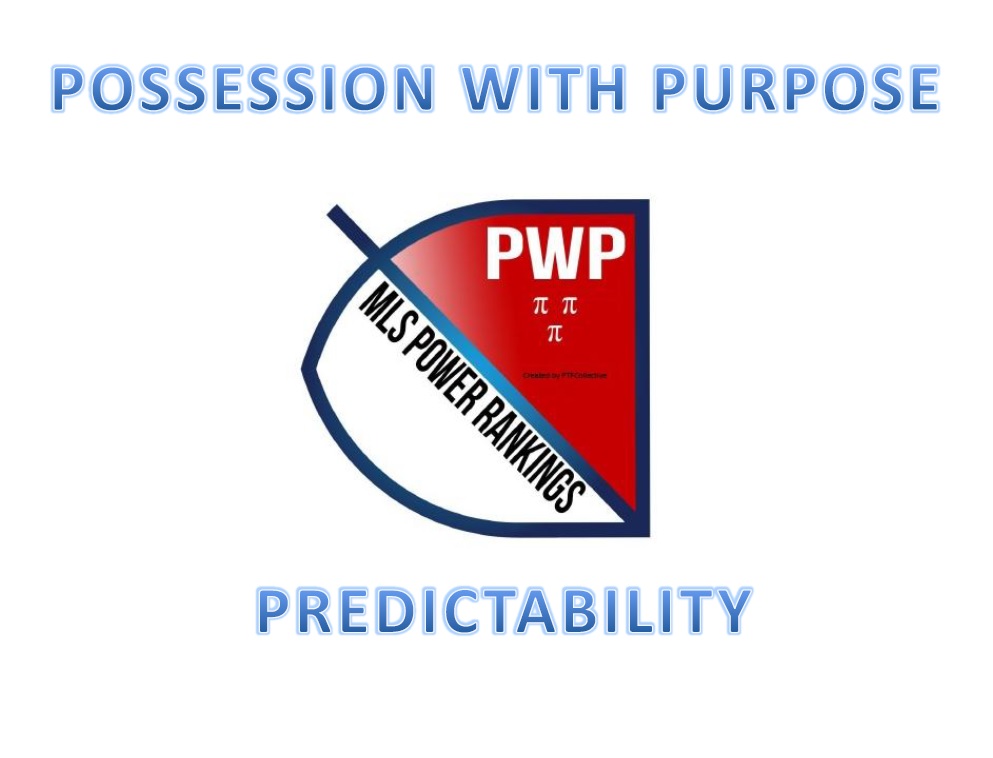
CAN IT BE DONE?
Over the last four years I’ve conducted research on various professional soccer leagues and competitions. To include Major League Soccer, the English, German, and Spanish Premier Leagues, as well as the UEFA Champions League and the Men’s World Cup of 2014.
Here’s my latest analyses on how the Possession with Purpose Index can be used to predict which teams will make the playoffs, qualify for the UEFA Champions League, or make the semi-finals of the World Cup..
Before beginning here’s a rerun on a few important items of interest about Possession with Purpose:
Intent: Develop a simplified, strategic set of performance indicators to better understand the outcome of a game based upon primary inputs.
End State:
- A documented method for measuring team performance from those indicators.
- An index that ranks teams for their performance based on this method.
- The index, while excluding points, comes close to matching results in the MLS league table.
- Bonus – unexpected outcome – a tool to predict teams making the MLS Playoffs.
Key events to date:
- Objective index developed in 2013
- Results presented at the World Conference on Science and Soccer 2014
- Approach published in the book – International Research Science and Soccer II – Routledge, Taylor, and Francis 2016
- Leagues/Competitions evaluated
- MLS 2013, 2014, 2015, 2016
- English Premier League 2014
- Bundesliga 2014
- La Liga 2014
- European Championship League 2014
- Men’s World Cup 2014
Major League Soccer 2013 – The Maiden Year for PWP:
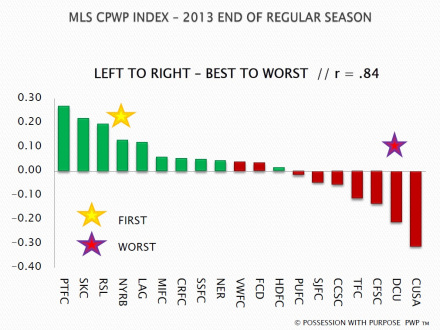
- Nine of the top ten teams in the CPWP Index made the MLS Playoffs in 2013
- Internal outputs from team performances showed that teams who cede possession (have lower than 50% possession) can be ranked within the top ten so the index is not biased towards teams that possess the ball greater than 50%
- This doesn’t even include all the internal evidence on the various tactical styles of play each coach advocated.
- Three of the bottom four teams replaced their head coaches as well.
- It’s the initial results here that provided me compelling information to investigate deeper into what the outputs of the index might offer.
- Each subsequent index shows a gold and red star – indicating which team finished first and last in the league table.
English Premier League 2014:
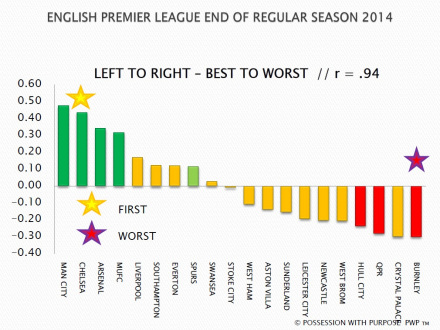
- Winner of the League, Chelsea, finished 2nd in the index.
- All four of the top four teams in the index advanced to the UEFA Champions League; those teams with green bars.
- By week 16, of 38 weeks, the four teams who advanced to 2015 UEFA Champions League were the top four teams in the Index; and they didn’t move out of the top four the rest of the season!
- Three of the bottom four teams in the index were relegated in 2014; those teams with red bars.
Germany Premier League 2014:
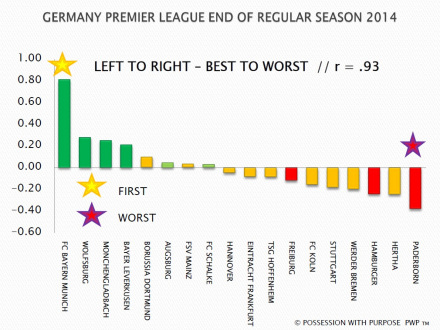
- Winner of the League, Bayern Munich, finished 1st in the index.
- All four of the top four teams in the index advanced to the UEFA Champions League; green bars.
- By week 21 the four teams who advanced to 2015 UEFA Champions League were the top four teams in the Index; and they didn’t move out of the top four the rest of the season!
- Augsburg and FC Schalke, who advanced to Europa League, finished 6th and 8th, respectively, in the index (light green bars).
- For those teams relegated (red bars), SC Paderborn, finished worst in the league table and index, while Freiburg was 7th worst in the index and Hamburger SV was 3rd worst in the index.
Spanish Premier League 2014:
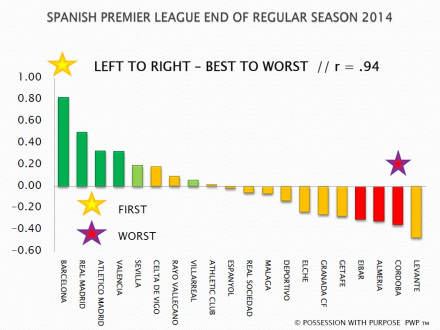
- Winner of the League, Barcelona, finished 1st in the index.
- All four of the top four teams in the index advanced to the UEFA Champions League; green bars.
- By week 14 the four teams who advanced to 2015 UEFA Champions League were the top four teams in the Index; and they didn’t move out of the top four the rest of the season!
- Sevilla and Villarreal, the two teams advancing to Europa League finished 5th and 6th, respectively, in the index; light green bars.
- The three teams relegated in 2014 were Cordoba, Almeria, and Eibar. They finished 2nd worst, 3rd worst, and 4th worst (respectively) in the index; red bars.
- Of note; Levante, who finished worst in the 2014 CPWP Index finished last in the 2015 La Liga Standings.
UEFA Champions League 2014:
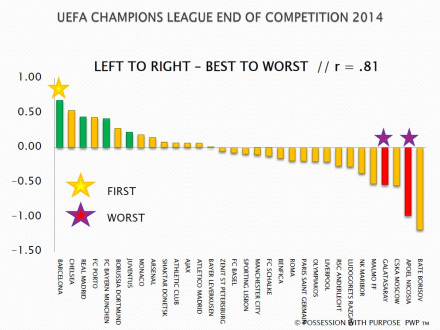
- Winner and top team in the Index – Barcelona
- Four of the seven top teams in the index advanced to the semi-finals
- Barcelona 1st, Real Madrid 3rd, FC Bayern Munich 5th, and Juventus 7th; green bars.
- By the end of round one the top four teams to make the semi-finals were all in the top 10 for the index; with Barcelona 1st, Bayern Munich 3rd, Real Madrid 4th, and Juventus 9th.
- Poor performers, APOEL Nicosia and Galatasaray finished 2nd and 4th worst (respectively) in the index; red bars.
Men’s World Cup 2014:
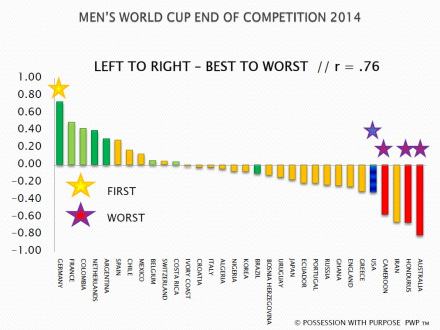
- Winner of the World Cup. Germany, finished 1st in the index, with 2nd place finisher, Argentina 5th best in the index.
- Four of the top seven teams to reach the semi-finals finished 1st, 2nd, 5th, and 7th in the index; green bars.
- By the end of round one, the four teams to make it so the semi-finals were all in the top six of the CPWP Index; with eventual winners, Germany 1st, Argentina 3rd, Netherlands 5th, and Brazil 6th.
- With Brazil giving up seven goals to Germany in the semi-finals they dropped from 7th to 18th in the index.
- France, Colombia, Belgium, and Costa Rica are the teams who made it to the quarter finals; light green bars.
- All three teams that failed to earn a point in the World Cup finished worst (Australia), 2nd worst (Honduras), and 4th worst (Cameroon); red bars.
Side note about the Men’s World Cup:
- USA finished 5th worst in the index (blue bar).
- At that time I called for Jurgen Klinsmann to be sacked. Why?
- My two most compelling reasons were:
- Omitting Landon Donovan from the squad (huge reduction in squad mentality/leadership without his presence – plus he was simply the best striker/forward in the USA).
- Replacing Graham Zusi with Omar Gonzalez late on in the game against Portugal – that replacement (a huge tactical error) created a vacancy in the area where Graham Zusi was defending; the exact same area where Ronaldo delivered his killer cross from.
- Two years later, after numerous tactical and mental leadership errors, Jurgen Klinsmann was finally sacked.
- I wonder where our team would be (NOW) if Sunil Gulati would have had the backbone to sack Jurgen Klinsmann back then?
- I’m not afraid to say I told you so Sunil Gulati…
Major League Soccer 2014:
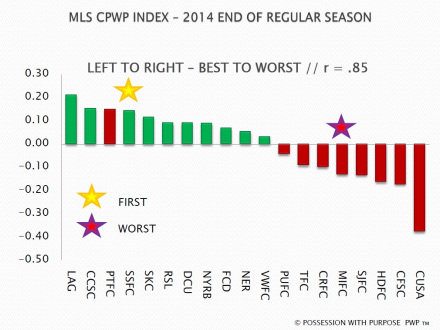
- Four of the top ten teams, after week 1 CPWP Index, made the playoffs; with SSFC, eventual Supporter Shield winners in third. After week 13 Seattle never fell further than 3rd in the Index.
- Eventual Cup winners, LA Galaxy, were 11th after week one. By week 8 they were 1st in the Index and did not fall out of the top two after week nine.
- Slow starter award goes to DC United, who were bottom of the Index until the end of week 5; when they finally breached the top ten.
- It was here, along with seeing FC Dallas, at the top of the Index, that reinforced the Index was not overly influenced by teams who have high amounts of possession.
- In other words, the Index would, and does, rank teams in the top ten even when they cede possession and play more direct/counter attacking football.
- Although the first four weeks of the Index didn’t predict more than four of the top ten teams making the playoffs by week eight the Index showed nine of the top ten teams making the playoffs.
- The level of accuracy, from week eight, going forwards never dropped below 70% and reached (and sustained 90% accuracy) by week 25 for the remainder of the year.
- Accuracy in predicting the top ten teams making the playoffs was no worse than 40% (the first four weeks) and no less than 70% throughout the remainder of the year with 90% accuracy first attained by week eight – and sustained by week 25.
Major League Soccer 2015:
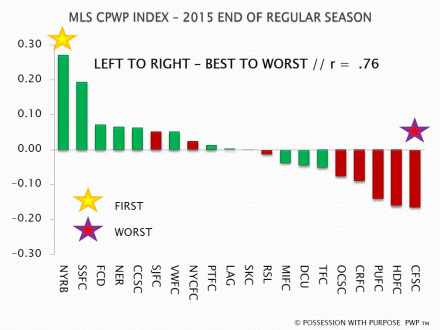
- Seven of the top ten teams, after week 1 CPWP Index, made the playoffs; with NYRB, eventual Supporter Shield winners in ninth.
- Eventual Cup winners, Portland, were 8th after week one.
- Slow starter award goes to New England, who started at bottom after week one, but had breached the top ten by week seven.
- At no time did the CPWP Index have less than seven eventual playoff teams in the top ten. And by week seven nine of the top ten teams in the Index were bound for the playoffs.
- Accuracy in predicting the top ten teams making the playoffs was no worse than 70% at any given time – and as high as 90% accurate by week seven.
Major League Soccer 2016:
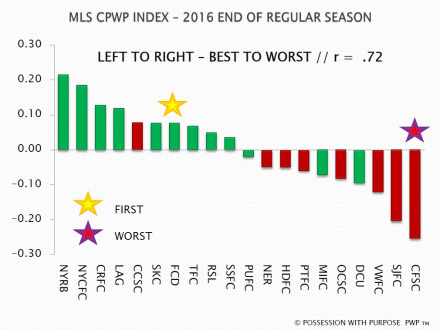
- Seven of the top ten teams, after week 1 CPWP Index, made the playoffs; with FCD, eventual Supporter Shield winners in first.
- For those who were surprised by the Colorado Rapids this year – you shouldn’t be. By week, the CPWP Index had Colorado Rapids as third best in MLS; and they didn’t move out of the top four, in the Index, the rest of the year.
- Slow starter award goes to New York Red Bulls; it wasn’t until week 12 that the Red Bulls breached the top four, but by week 14 they found their place at the top of the Index.
- At no time did the CPWP Index have fewer than six of the eventual playoff teams out of the top ten. And by week 25 nine of the top ten teams in the Index were bound for the playoffs.
- Accuracy in predicting the top ten teams making the playoffs was no worse than 60% at any given time – and as high as 90% accurate by week 25.
Closing Thoughts:
- The CPWP Index, and the sub-indices for team attacking and defending, show great value in looking to understand where failure/success may be occurring relative to team results.
- It’s evidence – one piece of evidence – that shareholders should pay attention to when looking to make changes – it is not a substitute for what the eye sees or the gut feels.
- I know more can be offered in drilling down into individual statistics relative to these team statistics.
Best, Chris
You can follow me on twitter @Chrisgluckpwp.
COPYRIGHT – All Rights Reserved. PWP – Trademark

